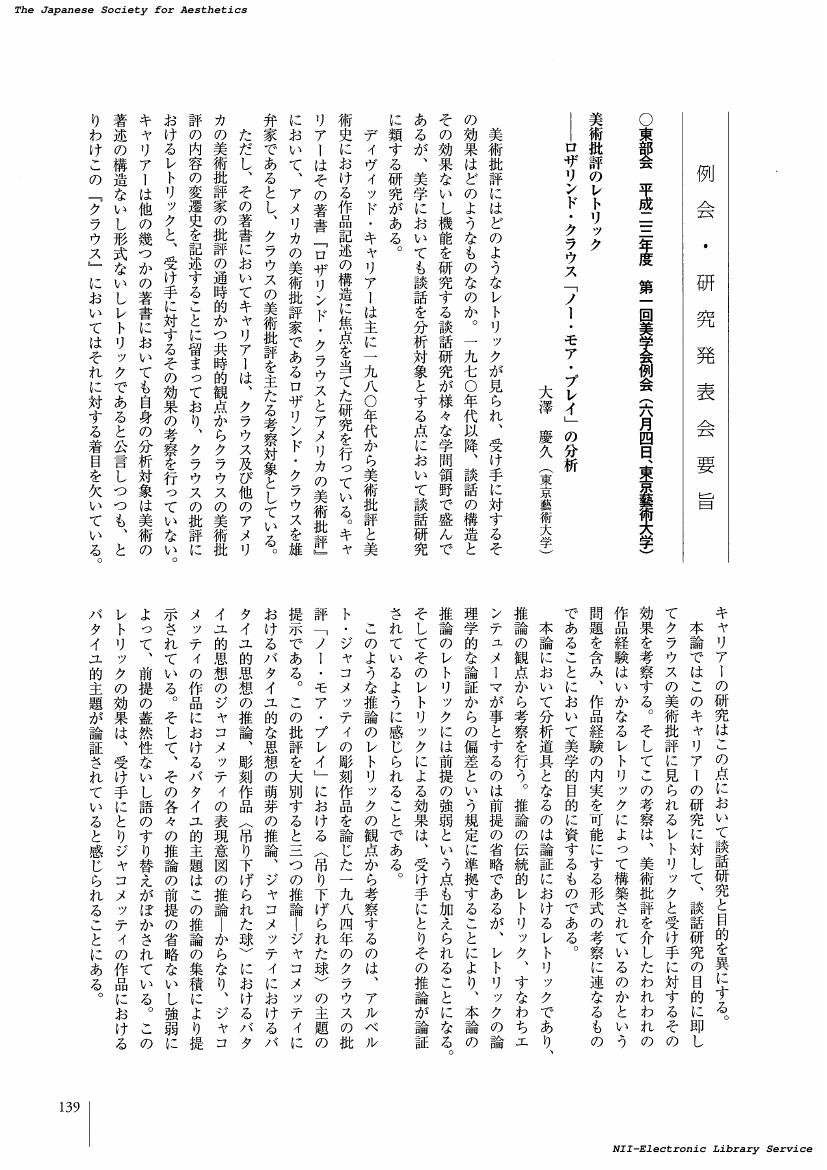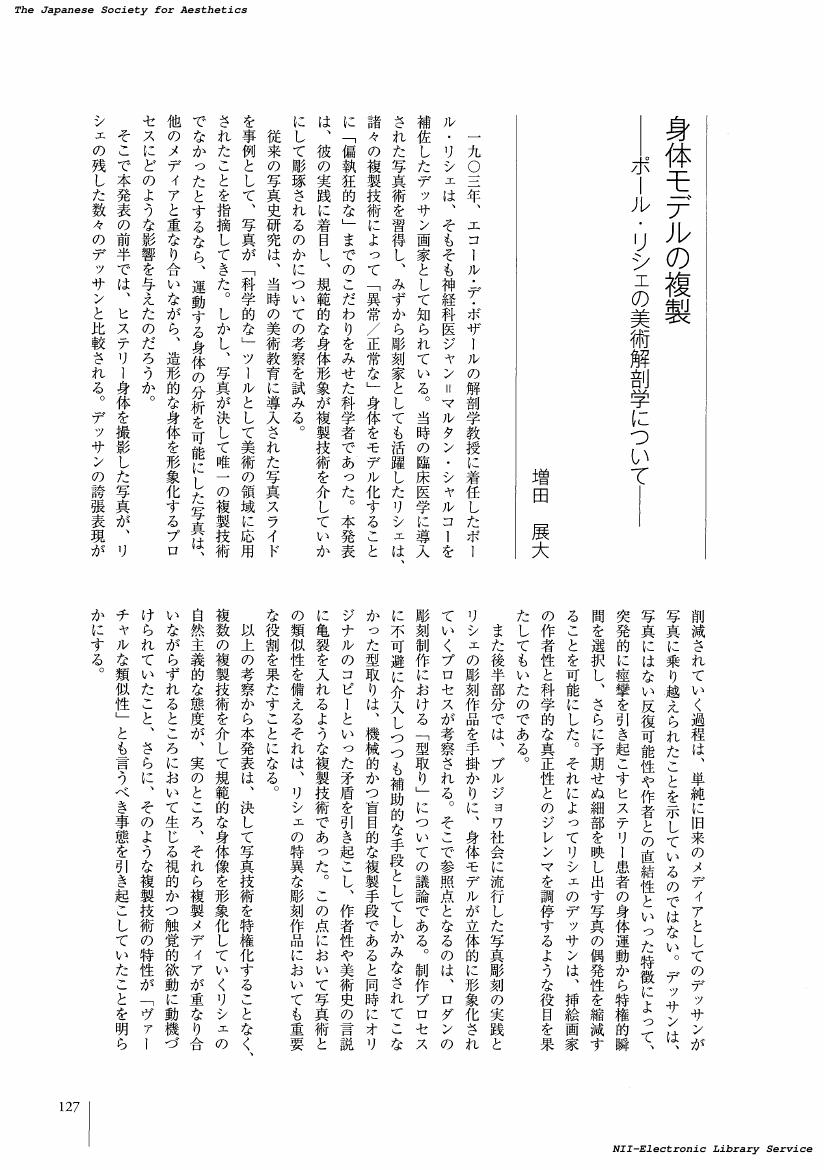1 0 0 0 OA ヴィーナスとルシファー : ベンヤミンの仮象概念についての一考察
- 著者
- 村上 真樹
- 出版者
- 美学会
- 雑誌
- 美学 (ISSN:05200962)
- 巻号頁・発行日
- vol.63, no.1, pp.13-24, 2012-06-30 (Released:2017-05-22)
In Goethes Wahlverwandtschaften (1920/21) betrachtet Walter Benjamin das Problem der Schonheit und des Scheins. Und dann beabsichitigt er sie zu uberwinden. Benjamin unterscheidet zwei Formen des Scheins; "Venus" und "Lucifer". Der Schein als Venus ist der "Schein hinter dem sich etwas verbirgt". Das stimmt mit dem Begriff des Scheins in der idealistischen Asthetik uberein. Der Schein als Lucifer ist der "Schein hinter dem sich Nichts verbirgt". Das stimmt mit dem Schein in Nietzsches Asthetik uberein. Aber betrachtet Benjamin beide Formen des Scheins kritisch. Die Erstere lasst er an ihrem Wert verlieren, indem er sie nicht als die Hulle vor der Wahrheit, sondern als Hulle vor dem "Unscheinbaren" begreift. Die Letztere verneinte er, indem er sie nicht als Schein, sondern als Allegorie begreift. Ferrier weist Benjamin auf ein Moment von Unterbrechung dieser Formen des Scheins hin, nennt dies "das Ausdruckslose". Meine Arbeit weist darauf hin, dass Benjamin fur die Uberwindung des Scheins drei Methoden vorschlagt; (1) Verminderung des Scheins durch die Beziehung zwischen Schonheit und Wahrheit zu schneiden, (2) Entzauberung des Scheins durch die Allegorie, (3) Unterbrechung des Scheins durch "das Ausdruckslose".
1 0 0 0 OA サルトル『聖ジュネ』における不道徳作品の「善用」
- 著者
- 森 功次
- 出版者
- 美学会
- 雑誌
- 美学 (ISSN:05200962)
- 巻号頁・発行日
- vol.63, no.1, pp.37-48, 2012-06-30 (Released:2017-05-22)
In the last section of Saint Genet (1952), Jean-Paul Sartre attempts to vindicate Jean Genet's immoral works. Sartre tries to save Genet from severe moral criticism in French literary world at the time. In this paper, I will organize Sartre's argument and examine his complex defense. According to Sartre, the immorality of Genet's works consists in the veriter's devious intention to invert our values and the bad influence he has on his readers. On the other hand, Sartre claims that Genet's works have some moral merits: to give readers some understanding of what Sartre calls 'solitary' positions such as Genet's, and to impress upon readers an identical possibility for themselves. Moreover, these moral merits are supported by the aesthetic appreciation of his works. The fact that readers could fully appreciate Genet's immoral works irresistibly points out to the readers the relation between themselves and the immorality of the works. It is not, however, clear how these moral merits are able to overcome the criticism against Genet. Moreover, because Sartre's argument presupposes an appreciation that deviates from Genet's own intention, which Sartre himself recognizes, it is not clear whether or not Sartre's attempted vindication can be viewed as a legitimate evaluation of Genet's works.
- 著者
- 新倉 慎右
- 出版者
- 美学会
- 雑誌
- 美学 (ISSN:05200962)
- 巻号頁・発行日
- vol.63, no.1, pp.49-60, 2012-06-30 (Released:2017-05-22)
There was the first version of Michelangelo's Christ in Santa Maria sopra Minerva in Roma which had been abandoned before the completion. In 2000, Baldriga and Squarzina identified the statue of Christ in San Vincenzo Martire at Bassano Romano with the lost first version. Although they argued only about the difference of the posture between two statues of Christ in Roma and in Bassano Romano, the rediscovery is very important for the reconsideration of the shape of Christ in Roma, because being executed under the same condition of the contract the difference makes the progress of Michelangelo's idea from Christ in Bassano Romano to that in Roma clear. This paper examines the importance of Christ in Roma to Michelangelo's transition of the style in statue. The factors (mainly the twist of the body and the position of the arm) that make the apparent difference between two statues of Christ appear on the works that Michelangelo executed after Christ in Roma, and it is this Christ that Michelangelo boldly made at first time under such idea which he would continue to utilize for realizing his statue. Therefore, contrary to the comparatively low evaluation of the modern studies, Christ in Roma occupies fixed position in the stylistic history of Michelangelo's statue.
- 著者
- 武田 宙也
- 出版者
- 美学会
- 雑誌
- 美学 (ISSN:05200962)
- 巻号頁・発行日
- vol.62, no.2, pp.146, 2011-12-31 (Released:2017-05-22)
- 著者
- 早川 恭只
- 出版者
- 美学会
- 雑誌
- 美学 (ISSN:05200962)
- 巻号頁・発行日
- vol.62, no.2, pp.148, 2011-12-31 (Released:2017-05-22)
- 著者
- 佐野 みどり
- 出版者
- 美学会
- 雑誌
- 美学 (ISSN:05200962)
- 巻号頁・発行日
- vol.62, no.2, pp.149, 2011-12-31 (Released:2017-05-22)
- 著者
- 加藤 隆文
- 出版者
- 美学会
- 雑誌
- 美学 (ISSN:05200962)
- 巻号頁・発行日
- vol.62, no.2, pp.150, 2011-12-31 (Released:2017-05-22)
1 0 0 0 OA ボナヴェントゥラの三位一体論的美学(西部会第二八五回研究発表会,例会・研究発表会要旨)
- 著者
- 横道 仁志
- 出版者
- 美学会
- 雑誌
- 美学 (ISSN:05200962)
- 巻号頁・発行日
- vol.62, no.2, pp.151, 2011-12-31 (Released:2017-05-22)
1 0 0 0 OA 津上英輔, 『あじわいの構造 感性化時代の美学』, 春秋社, 二〇一〇年, 二五八頁
- 著者
- 春木 有亮
- 出版者
- 美学会
- 雑誌
- 美学 (ISSN:05200962)
- 巻号頁・発行日
- vol.62, no.2, pp.135-138, 2011-12-31 (Released:2017-05-22)
- 著者
- 大澤 慶久
- 出版者
- 美学会
- 雑誌
- 美学 (ISSN:05200962)
- 巻号頁・発行日
- vol.62, no.2, pp.139, 2011-12-31 (Released:2017-05-22)
- 著者
- 小田 昇平
- 出版者
- 美学会
- 雑誌
- 美学 (ISSN:05200962)
- 巻号頁・発行日
- vol.62, no.2, pp.141-142, 2011-12-31 (Released:2017-05-22)
- 著者
- 小林 典子
- 出版者
- 美学会
- 雑誌
- 美学 (ISSN:05200962)
- 巻号頁・発行日
- vol.62, no.2, pp.143, 2011-12-31 (Released:2017-05-22)
- 著者
- 山下 純照
- 出版者
- 美学会
- 雑誌
- 美学 (ISSN:05200962)
- 巻号頁・発行日
- vol.62, no.2, pp.144, 2011-12-31 (Released:2017-05-22)
- 著者
- 外山 紀久子
- 出版者
- 美学会
- 雑誌
- 美学 (ISSN:05200962)
- 巻号頁・発行日
- vol.62, no.2, pp.145, 2011-12-31 (Released:2017-05-22)
- 著者
- 増田 展大
- 出版者
- 美学会
- 雑誌
- 美学 (ISSN:05200962)
- 巻号頁・発行日
- vol.62, no.2, pp.127, 2011-12-31 (Released:2017-05-22)
- 著者
- 松谷 容作
- 出版者
- 美学会
- 雑誌
- 美学 (ISSN:05200962)
- 巻号頁・発行日
- vol.62, no.2, pp.128, 2011-12-31 (Released:2017-05-22)
- 著者
- 村上 真樹
- 出版者
- 美学会
- 雑誌
- 美学 (ISSN:05200962)
- 巻号頁・発行日
- vol.62, no.2, pp.129, 2011-12-31 (Released:2017-05-22)
- 著者
- 村上 龍
- 出版者
- 美学会
- 雑誌
- 美学 (ISSN:05200962)
- 巻号頁・発行日
- vol.62, no.2, pp.130, 2011-12-31 (Released:2017-05-22)
1 0 0 0 OA サルトル『聖ジュネ』における「不道徳作品」の善用(第六十二回美学会全国大会発表要旨)
- 著者
- 森 功次
- 出版者
- 美学会
- 雑誌
- 美学 (ISSN:05200962)
- 巻号頁・発行日
- vol.62, no.2, pp.131, 2011-12-31 (Released:2017-05-22)
- 著者
- 森田 優子
- 出版者
- 美学会
- 雑誌
- 美学 (ISSN:05200962)
- 巻号頁・発行日
- vol.62, no.2, pp.132, 2011-12-31 (Released:2017-05-22)
















